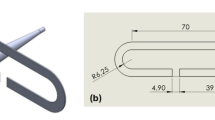Abstract
In the industrial environment, specifically in the automotive industry, an accurate prediction of execution times for each production task is very useful in order to plan the work and to optimize the human, technical and material resources. In this paper, we applied several regression neural networks to predict the execution times of the tasks in the production of parts for plastic injection molds. These molds are used to make a variety of car components in automotive industry. The prediction is based on the geometric features of the mold parts to be made. The accuracy of the predicted times is high enough to be used as a tool for the design stage of the mold parts, e.g. guiding the design process in order to get the lowest production time.










Similar content being viewed by others
Explore related subjects
Discover the latest articles, news and stories from top researchers in related subjects.References
Plossl G (1994) Orlicky’s material requirements planning. McGraw-Hill, NY
Cheng T, Podolsky S (1996) Just-in-Time manufacturing—an introduction. Springer, NY
Troqueles y Moldes de Galicia S.A. http://www.tromosa.es
Siemens PLM Software. http://www.plm.automation.siemens.com/en_us/products/nx
Li X, Hu B, Du R (2008) Predicting the parts weight in plastic injection molding using least squares support vector regression. IEEE Trans Syst Man Cybern—Part C: Appl Rev 38(6):827–833
Shen C, Wang L, Li Q (2007) Optimization of injection molding process parameters using combination of artificial neural network and genetic algorithm method. J Mater Process Technol 183(2–3):412–418
Venkatesan D, Kannan K, Saravanan R (2009) A genetic algorithm-based artificial neural network model for the optimization of machining processes. Neural Comput Appl 18(2):135–140
Yarlagadda P, Khong C (2001) Development of an integrated neural network system for prediction of process parameters in metal injection moulding. J Mater Process Technol 118(1–3):109–115
Kenig S, Ben-David A, Omer M, Sadeh A (2001) Control of properties in injection molding by neural networks. Eng Appl Artif Intell 14(6):819–823
Chen WC, Tai PH, Wang MW, Deng WJ, Chen CT (2008) A neural network-based approach for dynamic quality prediction in a plastic injection molding process. Expert Syst Appl 35(3):843–849
Huang S, Tan K, Lee T (2004) Neural-network-based predictive learning control of ram velocity in injection molding. IEEE Trans Syst Man Cybern Part C: Appl Rev 34(3):363–368
Smola AJ, Scholkopf B (1998) A Tutorial on Support Vector Regression. NeuroCOLT2 Technical Report Series, NC2-TR-1998-030. http://www.citeseer.ist.psu.edu/smola98tutorial.html
Vapnik V (1998) Statistical learning theory. Wiley, NY
Chen S, Cowan C, Grant P (1991) Orthogonal least squares algorithm for radial basis function networks. IEEE Trans Neural Netw 2(2):302–309
Chen S, Hong X, Harris C, Hanzo L (2008) Fully complex-valued radial basis function networks: orthogonal least squares regression and classification. Neurocomputing 71(16–18):3421–3433
Poggio T, Girosi F (1990) Networks for approximation and learning. Proc IEEE 78(9):1481–1497
Yao W, Chen X, Luo W (2009) A gradient-based sequential radial basis function neural network modeling method. Neural Comput Appl 18(5):477–484
Haddadnia J, Faez K, Ahmadi M (2003) A fuzzy hybrid learning algorithm for radial basis function neural network with application in human face recognition. Pattern Recognit 36(5):1187–1202
Yu DL, Yu DW (2007) A new structure adaptation algorithm for RBF networks and its application. Neural Comput Appl 16(1):91–100
Nissen S (2003) FANN: Fast Artificial Neural Networks, v. 2.1.0. http://www.fann.sourceforge.net
Igel C, Husken M (2003) Empirical evaluation of the improved Rprop learning algorithms. Neurocomputing 50:105–123
Riedmiller M, Braun H (1993) A direct adaptive method for faster backpropagation learning: The RPROP algorithm. In: Proceedings of 1993 IEEE International Conference on Neural Networks, pp 586–591
Fahlman SE (1988) Faster-learning variations on back-propagation: an empirical study. In: Proceedings of the 1988 connectionist models summer school, pp 38–50. Morgan-Kaufmann
Specht D (1991) A general regression neural network. IEEE Trans Neural Netw 2:568–576
Li W, Luo T, Zhu Q, Liu J, Le J (2008) Applications of AR*-GRNN model for financial time series forecasting. Neural Comput Appl 17(5–6):441–448
Fahlman SE, Lebiere C (1990) The cascade-correlation learning architecture. In: Advances in neural information processing systems, vol 2. Morgan-Kaufmann, pp 524–532
Gao X, Wang X, Ovaska S (2009) Fusion of clonal selection algorithm and differential evolution method in training cascade-correlation neural network. Neurocomputing 72:2483–2490
Duda R, Hart P, Storck D (2001) Pattern classification. Wiley, NY
Yap K, Lim C, LZ A (2008) A hybrid ART-GRNN online learning neural network with an ɛ-insensitive loss function. IEEE Trans Neural Netw 19(9):1641–1646
Williamson J (1996) Gaussian ARTMAP: a neural network for fast incremental learning of noisy multidimensional maps. Neural Netw 9(5):881–897
Chang CC, Lin CJ (2008) LIBSVM: a library for support vector machines. http://www.csie.ntu.edu.tw/~cjlin/libsvm
Hsu CH, Chang CC (2008) A practical guide to support vector classification. http://www.csie.ntu.edu.tw/~cjlin/papers/guide/guide.pdf
Sheskin D (2006) Handbook of parametric and nonparametric statistical procedures. CRC Press, Boca Raton
Garcia D, Herrera F, Research Group on soft computing and information intelligent systems. http://www.sci2s.ugr.es/sicidm/#eight
Acknowledgments
This work was supported by the Spanish Ministry of Education and Science (MEC) and the European Regional Development Fund of the European Commission (FEDER) under project TIN2006-15460-C04-02, and by the Xunta de Galicia under project 08MMA010402PR.
Author information
Authors and Affiliations
Corresponding author
Rights and permissions
About this article
Cite this article
Fernández-Delgado, M., Reboreda, M., Cernadas, E. et al. A comparison of several neural networks to predict the execution times in injection molding production for automotive industry. Neural Comput & Applic 19, 741–754 (2010). https://doi.org/10.1007/s00521-009-0332-5
Received:
Accepted:
Published:
Issue Date:
DOI: https://doi.org/10.1007/s00521-009-0332-5




